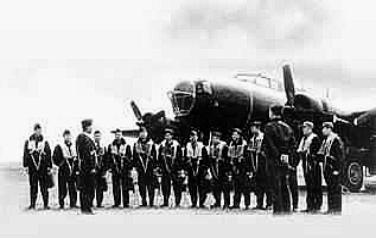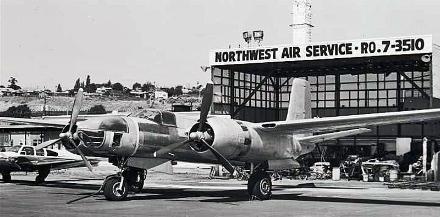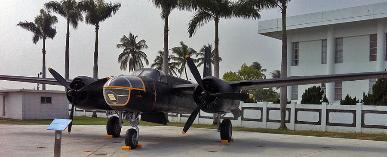A Bit 'Black Bat' of History
The 'Black Bat' - R.O.C. Air force Squadron -
Based in Taiwan during the Cold War.
In the early 1950s, when the US was engaged in the Korean War,
the US government recognized the strategic role that Taiwan could
play and decided to work more closely with Taiwan.
The Nationalist Government in Taiwan at the time had its own
agenda, with President Chiang Kai-shek still hoping to one day
retake China. For this, he would need US military aid.
A secret cooperation between the two began through the
establishment of Western Enterprises, Inc in Taipei, which was
composed mainly of experienced combat and intelligence specialists
from the Central Intelligence Agency (CIA). The purpose was to
facilitate the provision of advanced armaments and personnel
training from the US to Taiwan.
Some of the local trainees eventually became members of the 34th
Squadron, which was charged with flying secret low-altitude
reconnaissance flights over China. Special cameras were installed
on their planes (A 26C A26B), allowing them to capture photos of
China's military infrastructure. As they would only be sent for
missions at night, they were nicknamed the Black Bats Squadron.
The Bats reported directly to Taiwan's Air Force Intelligence
Administration, an organization independent of the Air Force's
chain of command.
General I Fuen was the chief of the administration and the main
coordinator between the US and Taiwan in this project .As the
actions taken by the Bats were highly classified, General I was
granted the authority to report directly to Chiang Kai-shek and his
son Chiang Ching-kuo.
Each member of the squadron was asked to write his will before he
began to fly missions. Each also was required to sign a document
demanding they keep all their actions secret.
Between 1955 and 1968, the Bats flew 838 missions, during which
142 officers were killed.
In the 2007 documentary The Secret Hidden in the Sky of Taiwan
director, Ting Wen-chin, located some members of the Bats
Squadron and persuaded them to tell their story.
Pilot Chu Cheng remembered being on a mission one night, when
Chinese planes got a lock on him soon after the team had
completed their task.
"They were following us closely and I couldn't fly any lower to the
ground," Chu recalled. "The situation left me with no time to think
about questions of life and death; I only knew I needed to find ways
to dodge."
Chu survived - but only because his attacker used up all his bullets.
The first-hand information the squadron collected enabled the US
to deliver an effective counter strategy against China's military
advancement.
The 'Black Bat' - R.O.C. Air force Squadron -
Based in Taiwan during the Cold War.
In the early 1950s, when the US was engaged in the Korean War,
the US government recognized the strategic role that Taiwan could
play and decided to work more closely with Taiwan.
The Nationalist Government in Taiwan at the time had its own
agenda, with President Chiang Kai-shek still hoping to one day
retake China. For this, he would need US military aid.
A secret cooperation between the two began through the
establishment of Western Enterprises, Inc in Taipei, which was
composed mainly of experienced combat and intelligence specialists
from the Central Intelligence Agency (CIA). The purpose was to
facilitate the provision of advanced armaments and personnel
training from the US to Taiwan.
Some of the local trainees eventually became members of the 34th
Squadron, which was charged with flying secret low-altitude
reconnaissance flights over China. Special cameras were installed
on their planes (A 26C A26B), allowing them to capture photos of
China's military infrastructure. As they would only be sent for
missions at night, they were nicknamed the Black Bats Squadron.
The Bats reported directly to Taiwan's Air Force Intelligence
Administration, an organization independent of the Air Force's
chain of command.
General I Fuen was the chief of the administration and the main
coordinator between the US and Taiwan in this project .As the
actions taken by the Bats were highly classified, General I was
granted the authority to report directly to Chiang Kai-shek and his
son Chiang Ching-kuo.
Each member of the squadron was asked to write his will before he
began to fly missions. Each also was required to sign a document
demanding they keep all their actions secret.
Between 1955 and 1968, the Bats flew 838 missions, during which
142 officers were killed.
In the 2007 documentary The Secret Hidden in the Sky of Taiwan
director, Ting Wen-chin, located some members of the Bats
Squadron and persuaded them to tell their story.
Pilot Chu Cheng remembered being on a mission one night, when
Chinese planes got a lock on him soon after the team had
completed their task.
"They were following us closely and I couldn't fly any lower to the
ground," Chu recalled. "The situation left me with no time to think
about questions of life and death; I only knew I needed to find ways
to dodge."
Chu survived - but only because his attacker used up all his bullets.
The first-hand information the squadron collected enabled the US
to deliver an effective counter strategy against China's military
advancement.
SPECIFICS
Role Light Bomber
Manufacturer Douglas Aircraft Company
First flight 10 July 1942
Retired 1980 Colombian Air Force
Primary users United States Army Air Forces, United States
Air Force, United States Navy, French Air Force,
R.O.C. "Black Bat' 34th Squadron - Taiwan
Number built 2,452, including 820 - Clam shell Design
Unit cost US$ 242,595
Variants A-26B - "solid" nose, A-26C - "glass" nose
CHARACTERISTICS
Crew: 3 (pilot, bombardier/navigator/pilot and gunner)
Length: 50 ft 0 in (15.24 m)
Wingspan: 70 ft 0 in (21.34 m)
Height: 18 ft 3 in (5.64 m)
Wing area: 540 ft² (50 m²)
Empty weight: 22,850 lb (10,365 kg)
Loaded weight: 27,600 lb (12,519 kg)
Max.take-off weight: 35,000 lb (15,900 kg)
Powerplant: 2 × Pratt & Whitney R-2800-27
"Double Wasp" radials, 2,000 hp
Maximum speed: 373 mph (308 kn, 570 km/h)
Range: 1,400 mi (1,200 nmi, 2,300 km)
Service ceiling: 22,000 ft (6,700 m)
Rate of climb: 1,250 ft/min (6.4 m/s)
Wing loading: 51 lb/ft² (250 kg/m²)
Power/mass: 0.145 hp/lb (108 W/kg)
Armament Guns: Up to 8 0.50 in - M2 Browning machine guns in the nose
8 0.50 in - M2 machine guns
2 0.50 in - M2 machine guns remote-
controlled dorsal turret
Bombs: 6,000 lb (2,700 kg) capacity -
4,000 lb (1,800 kg) in the bomb bay
2,000 lb (910 kg) carried on the wings
Role Light Bomber
Manufacturer Douglas Aircraft Company
First flight 10 July 1942
Retired 1980 Colombian Air Force
Primary users United States Army Air Forces, United States
Air Force, United States Navy, French Air Force,
R.O.C. "Black Bat' 34th Squadron - Taiwan
Number built 2,452, including 820 - Clam shell Design
Unit cost US$ 242,595
Variants A-26B - "solid" nose, A-26C - "glass" nose
CHARACTERISTICS
Crew: 3 (pilot, bombardier/navigator/pilot and gunner)
Length: 50 ft 0 in (15.24 m)
Wingspan: 70 ft 0 in (21.34 m)
Height: 18 ft 3 in (5.64 m)
Wing area: 540 ft² (50 m²)
Empty weight: 22,850 lb (10,365 kg)
Loaded weight: 27,600 lb (12,519 kg)
Max.take-off weight: 35,000 lb (15,900 kg)
Powerplant: 2 × Pratt & Whitney R-2800-27
"Double Wasp" radials, 2,000 hp
Maximum speed: 373 mph (308 kn, 570 km/h)
Range: 1,400 mi (1,200 nmi, 2,300 km)
Service ceiling: 22,000 ft (6,700 m)
Rate of climb: 1,250 ft/min (6.4 m/s)
Wing loading: 51 lb/ft² (250 kg/m²)
Power/mass: 0.145 hp/lb (108 W/kg)
Armament Guns: Up to 8 0.50 in - M2 Browning machine guns in the nose
8 0.50 in - M2 machine guns
2 0.50 in - M2 machine guns remote-
controlled dorsal turret
Bombs: 6,000 lb (2,700 kg) capacity -
4,000 lb (1,800 kg) in the bomb bay
2,000 lb (910 kg) carried on the wings
ABOUT The Douglas A-26 Invader (B-26 between 1948–1965)
was a United States twin-engined light attack bomber built by the
Douglas Aircraft Co. during World War II that also saw service
during several of the Cold War's major conflicts. A limited number
of highly modified aircraft (designation A-26 restored) served in
combat until 1969.
The redesignation of the type from A-26 to B-26 has led to popular
confusion with the Martin B-26 Marauder. Although both types
used the R-2800 engine, they are completely different designs.
DESIGN The A-26 was an unusual design for an attack bomber
of the early 1940s period, as it was designed as a single-pilot
aircraft (sharing this characteristic with the RAF's de Havilland
Mosquito, among others). The aircraft was designed by Edward
Heinemann, Robert Donovan, and Ted R. Smith. The project
aerodynamicist on the program was A.M.O. Smith, who designed
the wing making use of the then-new NACA 65-215 laminar flow
airfoil. The Douglas XA-26 prototype first flew on 10 July 1942 at
Mines Field, El Segundo, with test pilot Benny Howard at the
controls. Flight tests revealed excellent performance and handling,
but there were problems with engine cooling which led to cowling
changes and omission of the propeller spinners on production
aircraft, plus modification of the nose landing gear after repeated
collapses during testing.
The A-26 was originally built in two different configurations. The
A-26B had a "solid" nose, and officially termed the "all-purpose
nose", later commonly known as the "six-gun nose" or "eight-gun
nose".
The A-26C's "glass" nose, officially termed the "Bombardier nose",
contained a Norden bomb sight for medium altitude precision
bombing. The A-26C nose section included two fixed M-2 guns,
later replaced by underwing gun packs or internal guns in the wings.
After about 1,570 production aircraft, three guns were installed in
each wing, coinciding with the introduction of the "eight-gun nose"
for A-26Bs, giving some configurations as many as 14 .50 in (12.7
mm) machine guns in a fixed forward mount.
An A-26C nose section could be exchanged for an A-26B nose
section, or vice versa, in a few man-hours, thus physically (and
officially) changing the designation and operational role. The "flat-
topped" canopy was changed in late 1944 after about 820
production aircraft, to a clamshell style with greatly improved
visibility.
In an A-26C, that crew member served as navigator and
bombardier, and relocated to the nose section for the bombing
phase of an operation. A small number of A-26Cs were fitted with
dual flight controls, some parts of which could be disabled in flight
to allow limited access to the nose section. A tractor-style "jump
seat" was located behind the "navigator's seat." In most missions, a
third crew member in the rear gunner's compartment operated the
remotely-controlled dorsal and ventral gun turrets, with access to
and from the cockpit only possible via the bomb bay when that was
empty.
OPERATION
It made its first flight in July 1942, and production delivery began
in August 1943. The A-26 entered combat over Europe in
November 1944. By the time production halted after the end of
WWII, 2,502 Invaders had been built.
The A-26 was redesignated the B-26 in 1948. During the Korean
War, the B-26 became an important part of the USAF interdiction
campaign against communist ground forces. Initially B-26 crews
flew during the day, but the introduction of the MiG-15 jet fighter
forced them to fly most missions at night.
Early in the Southeast Asia War, the Invader went into action for
the third time. Also, the USAF ordered 40 modified B-26Bs with
more powerful engines and increased structural strength.
Designated the B-26K, the airplanes performed special air warfare
missions.
HISTORY of the A-26C #44-35444
Built: 1944
Manufacturer: Douglas
Serial #: 44-35444
Construction #: 28723
1944-1948 - WWII warbird: USAAF
1950-1953 - Korean War - USAFF
1953-1969 - R.O.C. Black Bat 34th Squadron
Overall, from 1953 to 1967, 34th Squadron flew 838 missions,
148 Black Bat crew members went down with 15 aircraft.
Recent History:
1969-1971 - Northwest Air Service - Seattle, WA,
Registered as N7656C.
1971-2006 - Air Spray Ltd, Edmonton, Alberta, 1971.
- Registered as CF-TFB and flew as Tanker #4.
Air Spray Ltd, Red Deer, Alberta, June 1973-2003.
- Registered as C-FTFB.
- Converted to Tanker at Chino, CA, 1975.
- Flown as Tanker #4/Miss Red Deer.
2006 - Sold to the Classic Aircraft Aviation Museum The Museum
returned Tanker #4 to Airworthy Status
January, 2012 - Moved to Taiwan for display at the Air Force
Museum next to RoCAF Academy in Kangshan, Taiwan.
Please click here to view the Black Bat assembly project in Taiwan
was a United States twin-engined light attack bomber built by the
Douglas Aircraft Co. during World War II that also saw service
during several of the Cold War's major conflicts. A limited number
of highly modified aircraft (designation A-26 restored) served in
combat until 1969.
The redesignation of the type from A-26 to B-26 has led to popular
confusion with the Martin B-26 Marauder. Although both types
used the R-2800 engine, they are completely different designs.
DESIGN The A-26 was an unusual design for an attack bomber
of the early 1940s period, as it was designed as a single-pilot
aircraft (sharing this characteristic with the RAF's de Havilland
Mosquito, among others). The aircraft was designed by Edward
Heinemann, Robert Donovan, and Ted R. Smith. The project
aerodynamicist on the program was A.M.O. Smith, who designed
the wing making use of the then-new NACA 65-215 laminar flow
airfoil. The Douglas XA-26 prototype first flew on 10 July 1942 at
Mines Field, El Segundo, with test pilot Benny Howard at the
controls. Flight tests revealed excellent performance and handling,
but there were problems with engine cooling which led to cowling
changes and omission of the propeller spinners on production
aircraft, plus modification of the nose landing gear after repeated
collapses during testing.
The A-26 was originally built in two different configurations. The
A-26B had a "solid" nose, and officially termed the "all-purpose
nose", later commonly known as the "six-gun nose" or "eight-gun
nose".
The A-26C's "glass" nose, officially termed the "Bombardier nose",
contained a Norden bomb sight for medium altitude precision
bombing. The A-26C nose section included two fixed M-2 guns,
later replaced by underwing gun packs or internal guns in the wings.
After about 1,570 production aircraft, three guns were installed in
each wing, coinciding with the introduction of the "eight-gun nose"
for A-26Bs, giving some configurations as many as 14 .50 in (12.7
mm) machine guns in a fixed forward mount.
An A-26C nose section could be exchanged for an A-26B nose
section, or vice versa, in a few man-hours, thus physically (and
officially) changing the designation and operational role. The "flat-
topped" canopy was changed in late 1944 after about 820
production aircraft, to a clamshell style with greatly improved
visibility.
In an A-26C, that crew member served as navigator and
bombardier, and relocated to the nose section for the bombing
phase of an operation. A small number of A-26Cs were fitted with
dual flight controls, some parts of which could be disabled in flight
to allow limited access to the nose section. A tractor-style "jump
seat" was located behind the "navigator's seat." In most missions, a
third crew member in the rear gunner's compartment operated the
remotely-controlled dorsal and ventral gun turrets, with access to
and from the cockpit only possible via the bomb bay when that was
empty.
OPERATION
It made its first flight in July 1942, and production delivery began
in August 1943. The A-26 entered combat over Europe in
November 1944. By the time production halted after the end of
WWII, 2,502 Invaders had been built.
The A-26 was redesignated the B-26 in 1948. During the Korean
War, the B-26 became an important part of the USAF interdiction
campaign against communist ground forces. Initially B-26 crews
flew during the day, but the introduction of the MiG-15 jet fighter
forced them to fly most missions at night.
Early in the Southeast Asia War, the Invader went into action for
the third time. Also, the USAF ordered 40 modified B-26Bs with
more powerful engines and increased structural strength.
Designated the B-26K, the airplanes performed special air warfare
missions.
HISTORY of the A-26C #44-35444
Built: 1944
Manufacturer: Douglas
Serial #: 44-35444
Construction #: 28723
1944-1948 - WWII warbird: USAAF
1950-1953 - Korean War - USAFF
1953-1969 - R.O.C. Black Bat 34th Squadron
Overall, from 1953 to 1967, 34th Squadron flew 838 missions,
148 Black Bat crew members went down with 15 aircraft.
Recent History:
1969-1971 - Northwest Air Service - Seattle, WA,
Registered as N7656C.
1971-2006 - Air Spray Ltd, Edmonton, Alberta, 1971.
- Registered as CF-TFB and flew as Tanker #4.
Air Spray Ltd, Red Deer, Alberta, June 1973-2003.
- Registered as C-FTFB.
- Converted to Tanker at Chino, CA, 1975.
- Flown as Tanker #4/Miss Red Deer.
2006 - Sold to the Classic Aircraft Aviation Museum The Museum
returned Tanker #4 to Airworthy Status
January, 2012 - Moved to Taiwan for display at the Air Force
Museum next to RoCAF Academy in Kangshan, Taiwan.
Please click here to view the Black Bat assembly project in Taiwan





| A-26C Tanker 4 and the "B-26 Black Bat Historical Project" |



| Air Spray Ltd, Red Deer, Alberta, June 1973-2003 |

| Members of the 34th "Black Bat" squadron listen to a briefing by commanders in a photo from 1959. |
| The A-26C on display was flown to the National Museum of the United States Air Force in September 1957. It appears in the colors and marking used during the Korean War by the 34th Bomb Squadron flying night intruder missions. |


